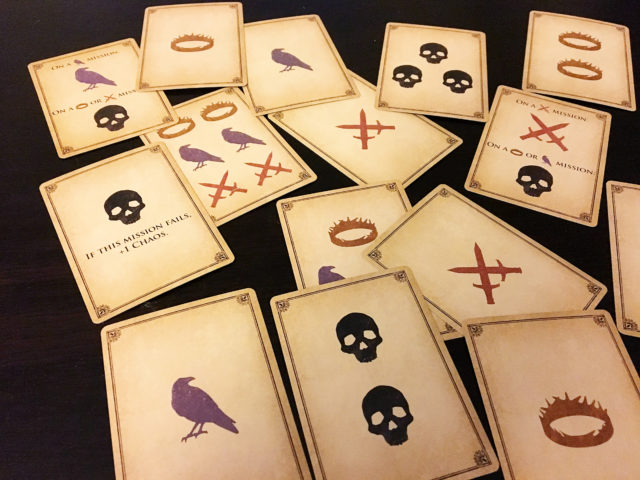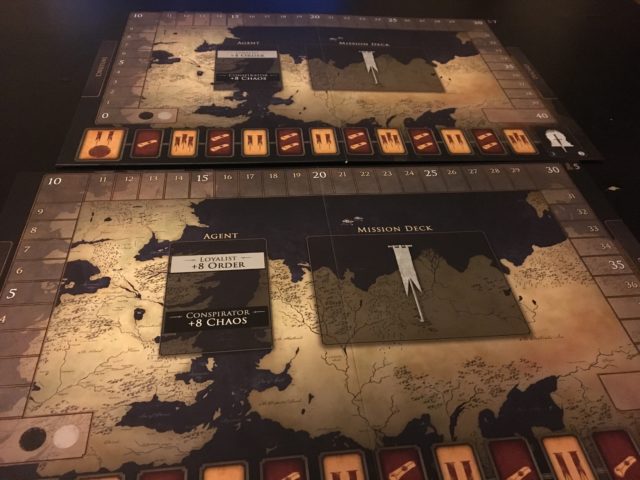Are you loyal like Ned Stark or treacherous like Petyr Baelish a.k.a. Littlefinger? If you don’t know what I am talking about, well I will do my best not to spoil the hit HBO show Game of Thrones, but for those that instantly answered Littlefinger than you should rush out and grab Dire Wolf Digital’s new boardgame Game of Thrones: Oathbreaker by designer Kevin Spak and art by Clay Brooks, Jon Schindehette and Nate Storm.

You need not be a fan of Game of Thrones to enjoy Oathbreker, a social-deduction game set in Westeros, but it sure adds to the experience. As with many social deduction games there are two teams competing against each other, in this case the good guys are said to be working for “order” and the bad guys are sowing “chaos.”
At the start of the game one player will assume the role of Queen or King of Westeros (there are two rulers working together in an 8-player game). This is open information, and everyone knows that King or Queen is working for the order side (there are no secret Mad King or Queen in this game).
The rest of the players will have three separate players characteristics.
Each player will claim a Great House of Westeros and pick their Lord or Lady (the player boards are two-sided). Each Lord or Lady has a special power.

Then each player will be given a secret card indicating whether they a loyal to the crown or a conspirator against the crown. Unlike some other social-deduction games, the conspirators will not who their fellow bad guys are. Also, in several cases there could be more conspirators than loyalists, which is the first time I’ve seen that in social-deduction games.
Lastly, every player gets a secret agenda they need to complete on their own if they want to claim victory. Do you seek power, hunger or coin? This last aspect is what helps Oathbreaker really stand out from other social-deduction games. It’s a similar idea to Dead of Winter, except whereas in that game most of the secret goals make every player look sketchy, in Oathbreaker the secret agendas might force bad guys to help out the good guys and vice versa.

The game plays over seven rounds in which the players who are not the King or Queen submit cards to various missions. If they pass, order is promoted, if they fail, chaos is rising.
The role of the King/Queen can be very tricky to play, especially to someone who is new to social-deduction games, so I’d suggest in the first few plays let the more experienced players take on that task. Very early on the King/Queen must make decisions on who to trust and who not to trust, often with very little information. Most of the time in the early game everyone seems good, but eventually the conspirators must do some dirty work and sow chaos before order takes control.

One of the biggest main advantages of Oathbreaker over many other social deduction games is that every player is involved in every round (there may be some cards played by the King/Queen that force players to play one way or another but that is a rare occurrence). In many other social-deduction games with large player counts some players are never picked to go on a mission or be part of the team and are not given any chance to prove their loyalty. I’ve played several games of Resistance/Avalon and Secret Hitler where one of two players in a 10-player game are essentially not playing for most or all of the game.
In Oathbreaker everyone in every round can do good, or bad things, often with the help of their unique player power to prove their loyalty or to sow chaos, perhaps by throwing someone else under the bus.
One of the loyalty cards is never dealt out, instead it is placed on the board. That way the group can never know for sure if there are 3 people playinh on the side of chaos or just two. To solve the balancing issue, whichever side has a loyalty card that is not dealt out is given and end-game point bonus, which could be the tipping point to victory.

The theme of the game is there, even if it’s not super strong and dependent on knowledge of the TV show or books. The missions and player characters, while given names and art related to the series, don’t always feel relevant and Oathbreaker could likely be reskinned for a non-IP universe and not lose too much from the game itself.
The component quality of the game is top notch. Some people might complain about the screen caps, but that’s never bothered me. I particularly loved the poker-chip like tokens given to each player with their house sigil and am constantly playing with mine during games, often to distraction of myself and others.
In conclusion, Oathbreaker is a worthy addition to the social-deduction genre with some new and reworked concepts that make the game not feel like a retread or clone of other games.
Game of Thrones: Oathbreaker is a bluffing, deduction card game for 5 to 8 players that plays in approximately 30 to 45 minutes. Designed by Kevin Spak with art by Clay Brooks, Jon Schindehette and Nate Storm. It is published by Dire Wolf Digital
Comments
No comments yet! Be the first!